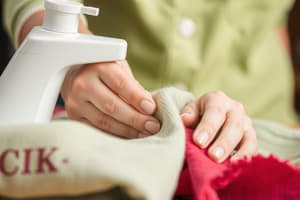Podcast
Questions and Answers
What is the primary purpose of care labels on textiles?
What is the primary purpose of care labels on textiles?
- To inform consumers of the fabric's origin
- To serve as decoration on clothing
- To indicate the brand of the product
- To provide washing and care instructions (correct)
Which textile items are exempt from mandatory care labelling?
Which textile items are exempt from mandatory care labelling?
- Furnishings
- Bedding products
- Household textiles
- Footwear textiles (correct)
What does a dry cleaning symbol represented by a circle with a P denote?
What does a dry cleaning symbol represented by a circle with a P denote?
- Do not dry clean at all
- Dry clean only with trichloroethylene
- Wash with hot water
- Dry clean with any solvent except trichloroethylene (correct)
What is one potential consequence of applying high heat to a low heat fabric?
What is one potential consequence of applying high heat to a low heat fabric?
Which of the following items typically requires care labelling?
Which of the following items typically requires care labelling?
Flashcards
Care labels
Care labels
Care labels are instructions on how to wash and maintain textile products, like clothing.
Dry cleaning symbol
Dry cleaning symbol
A simple circle representing dry cleaning, a circle with P for dry cleanable without Tri-chloroethylene and a big cross for no dry clean.
Care label implication (high heat)
Care label implication (high heat)
High heat on a garment requiring low heat can cause damage or burning.
Mandatory care labels
Mandatory care labels
Signup and view all the flashcards
Care labels: cotton bleaching
Care labels: cotton bleaching
Signup and view all the flashcards
Study Notes
Fabric Care and Maintenance
- Care labels are guidelines for washing and caring for products, like clothing.
- Labels provide instructions for laundry washers and dry cleaners, helping to maintain the quality of garments.
- Labels also help consumers preserve the longevity of products and prevent damage.
- Mandatory standards cover textiles like clothing, household textiles, furnishings, bedding, and mattresses.
- Other textile products, like items in footwear, medical supplies, and sanitary products, don't require care labeling.
Types of Care Labels
- Machine Wash: Indicates the garment can be washed in a machine.
- Hand Wash: Indicates the garment should be washed by hand.
- Delicate Cycle: Indicates the garment should be washed on a special delicate cycle in a machine.
- Do Not Wash: Indicates the garment should not be washed.
- Bleach OK: Indicates the garment is safe to bleach.
- Non-Chlorine Bleach Only: Indicates the garment can only be bleached with non-chlorine bleach.
- Do Not Bleach: Indicates the garment should not be bleached.
- Tumble Dry, Low Heat: Indicates the garment can be tumble dried on a low setting.
- Tumble Dry, Medium Heat: Indicates the garment can be tumble dried on a medium setting.
- Tumble Dry, High Heat: Indicates the garment can be tumble dried on a high setting.
- Do Not Dry: Indicates the garment should not be tumble dried.
Additional Care Label Symbols
- Dry Cleaning: A simple circle represents dry cleaning with any solvent except trichloroethylene; a circle with a large cross indicates no dry cleaning.
- Ironing: Symbols show different ironing temperatures (low, medium, high). A symbol with a line through it indicates the garment should not be ironed. A symbol with a line through a steam icon indicates no steam ironing.
Care Labels and Their Implications
- High heat on a fabric that demands low heat causes burning.
- Bleach symbols on garments indicate the garment may or may not be bleached. Black cotton garments should not be bleached because it damages the color.
- Care labels typically include washing instructions (temperature, separating colors, etc.) on the tag.
Studying That Suits You
Use AI to generate personalized quizzes and flashcards to suit your learning preferences.




